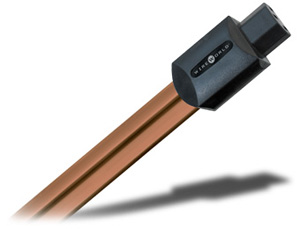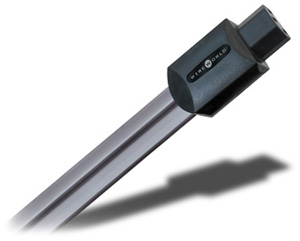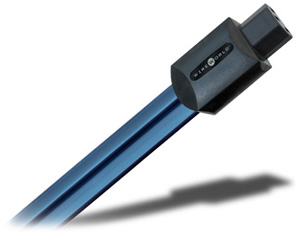
|

Wireworld
Electra 52, Silver Electra 52,
and Stratus 52 Power Cords

|
|
|
 |

DescriptionModel:
Silver Electra 52
Price: $699.95 USD per 2m cord
Model: Electra 52
Price: $359.95 USD per 2m cord
Model: Stratus 52
Price: $99.95 USD per 2m cord
Model: Tundra Shielded Power Cord Extender
Price: $69.95 USD
Warranty: Lifetime |

Features
- Silver-clad brass contacts (Silver Electra 52)
- Ohno Continuous Cast (OCC) silver-clad copper conductors
(Silver Electra 52)
- Ohno Continuous Cast (OCC) copper conductors (Electra 52)
- Oxygen-free copper conductors (Stratus 52)
- Brass contacts (Stratus 52)
- Double-wired for improved current flow (Tundra)
- IEC 320 power inlet (Tundra)
|
Cables have gone mainstream. Not that many
years ago, when you walked into a big-box store you were hard-pressed to find a decent
cable in the place. Now the cheapest HDMI cable you can find in the local big box pushes
$100 -- which is crazy, considering that most people use them to hook up mediocre, $150
DVD players. Where’s the value proposition in a cable that costs two-thirds what you
paid for the source you’re connecting with it?
To make the cut in my house, a cable must offer a threshold
of value -- measured by how much it enhances my system’s performance -- commensurate
with its cost. For the vast majority of my friends, to whom audio and video quality are
far less important than their checkbook balance, I recommend a number of good-quality,
inexpensive cables. For the handful who’ve passed over to our Dark Side, more careful
consideration is warranted.
In the past, I mainly recommended speaker cables and
interconnects to run between key components. It wasn’t until I reviewed the Blue
Circle BC606 that I began to place much credence in the ability of power cables to
significantly improve a system’s sound. After all, electrical power passes through
miles of garbage wire before it gets to your house -- how much difference can those last
few feet of high-tech wire make? It turns out there are ways in which those last few feet
can make a big difference.
From the start, what piqued my interest in Wireworld’s
52 line of power cables was what seemed to be the scientifically sound
reasoning behind their design. Wireworld makes no wild assertions that cables must be
bathed in the light from a crystal of kryptonite, or other such nonsense. Instead, they
designed their cables’ geometry and construction to drive the cables’ inductance
and capacitance values as high as possible, to create a cable that is also a passive
filter. The basic idea is that every 52 cable naturally rejects frequencies
above the 60Hz electrical carrier, effectively making it the equivalent of a power
conditioner. This may sound strange, but it makes a lot of sense. All cables have
properties of inductance, capacitance, and resistance, which are all that’s required
to create a filter. The idea of tweaking a cable design to generate a filter effect is not
only far from crazy, it borders on genius.
The power coming into my house from the electric company is
not clean to begin with. By the time it gets to my wall outlets, it’s been polluted
by enough additional grunge from electrical appliances and fluorescent lights to make
Donny Osmond sound like Nirvana. This is why, for years, I’ve used power conditioners
of varying capability. However, a few years ago I moved into a house that backs up to
fields of corn and beans. Suddenly, my house and the electric poles behind it were the
tallest things for about a mile in every direction. In the last four years, two minor
lightning strikes have killed a surge protector and a power conditioner and lightly
damaged an amplifier. Out here in the fields, power conditioning has taken a back seat to
high-quality -- and affordably replaceable -- surge protection.
What now pass for power conditioners in my house are
inexpensive Monster and Belkin units that were selected more for their surge-suppression
abilities and the fact that I was able to get them at low prices. If one of them is zapped
in the next electrical storm, I won’t lose any sleep over it. In addition to this,
Anthem states that my reference AVM 20 preamplifier-processor should not be plugged
into a power conditioner, so it’s generally plugged directly into a nonconditioning
power strip. In this house, any additional power conditioning that isn’t easily
subject to electrical damage is very welcome.
Setup

Silver Electra
|
Wireworld sent along a substantial pile of 52
power cords for consideration, as well as one of their Tundra Shielded Power Cord Extender
($69.95 USD), or power strip. I tried a variety of permutations, trying different
components with different cords, and ultimately settled on configurations that placed the
more expensive cords on the preamp-processor and amplifiers. At the time the 52s
arrived, I had three NuForce Reference 8.5 monoblocks on hand for review that I’d had
to plug into a power strip. I replaced my standard power strip with the Tundra and plugged
it into the wall outlet with a Wireworld Silver Electra 52 cord ($699.95). The
processor got a second Silver Electra 52. The left- and right-channel amps were
fed power via a pair of standard Electra 52s ($359.95). The only other
IEC-equipped component in my system at the time was a Toshiba HD-A1 HD DVD player, which I
plugged in with a Stratus 52 cord ($99.95). Later in the review cycle, I
replaced the Anthem pre-pro and NuForce amps with an Anthem Statement D2 and Anthem PVA 7
amplifier, both fed power by Silver Electra 52s. Because the new arrangement
freed up a handful of AC cords, I then swapped out the stock cord of my Cayin TA-30 tube
amp in the family room with one of the standard Electra 52 cords I’d used
on the NuForces.
There were a few other devices I’d have liked to try
with the Wireworld 52s, but in some cases was prevented by hardwired and/or
proprietary connectors. Most notable among these was the Panasonic PT-AE900 projector,
which I think might benefit substantially from a little power conditioning and a
better-built cord. It would also have been interesting to see what impact a Stratus 52
might have had on my scaling DVD players, but these all have non-IEC cords for which I had
no adapter plugs.
Listening
During the course of this review, I kept listening to
"Autumn Perspective," from Vanessa Daou’s Zipless [Lotus 1278]. The
entire album -- song settings of a handful of poems by Erica Jong -- is a fine piece of
minimalist music. The soundstage of this sparse musical score is wide and deep to begin
with, but with any of the Wireworld 52 cords in the system it opened up
dramatically, playing against a deeply silent backdrop.
This review might require a parental advisory. The second
CD I listened to was Ween’s Chocolate and Cheese [Elektra 61639], which
carries a Parental Advisory label. You should probably expect that from an album with a
track titled "Don’t **** Where You Eat." However, that track turned out to
be good review fodder for the 52s, which seemed to help separate the vocal
elements into a mesh of distinctly independent voices. The soundstage also opened up,
adding a greater sense of air around individual performers.
One of the hot new HD DVDs out right now is Grand Prix,
which has transferred to HD incredibly well by any standard, particularly for a film now
40 years old. The racing sequences are still some of the best ever filmed, and are
incredibly sharp. If you get motion sickness easily, make sure you sit a good distance
back from the screen. For this reissue, the soundtrack has been given the full 5.1-channel
Dolby Digital Plus treatment. There’s not much in the rear channels beyond a little
ambient information, but the front channels are just fine, aided in this instance by the
increased openness and transparency imparted by a pile of Wireworld 52s.
I also watched and listened to the HD DVD of The Phantom
of the Opera. At the risk of inciting angry letters from fans of Andrew Lloyd Weber,
let me state that I’m not a huge fan of this movie. It’s not the worst film I
use for evaluating equipment (that honor belongs to Driven), but I find the acting
pedestrian and the singing uninspired. For all the attention lavished on sets and
costumes, Phantom could and should have been so much better. The only reason I
bought this edition was for its decent HD DVD transfer and Dolby TrueHD soundtrack. The
good news is that the latter lives up to the TrueHD hype, at least technically. The
additional audio resolution provides a noticeable improvement over the original in just
about every area, and gives a high-performance audio system more to work with. It was with
this soundtrack, more than any other, that the Wireworld 52s provided the most
benefit, sharpening the focus on individual elements in the soundfield while opening up
the depth and breadth of the soundstage.
Random thoughts

Stratus
|
Being something of a cable skeptic,
I’ve mostly stuck with the stock IEC power cords provided with my various components,
and run a power conditioner between the components and the wall outlet. Figuring that the
conditioner would take care of the worst of the grunge coming down the AC line, I worried
more about surge protection. It stood to reason, at least in my mind, that a few feet of
high-quality wire at the end of the chain weren’t going to fix the ills the current
had gathered from its travel through the several miles of low-grade wire it passes through
before it gets to the outlet. The design of the 52 cables threw a wrench into
that line of thinking.
The truth is that the difference between the stock cords
and any of the Wireworld cords was immediate and obvious. The soundstage opened up, the
clarity improved, and the entire fabric of the music was set against a dead-silent
backdrop. To be sure, the difference was more pronounced in my acoustically treated and
optimized home theater than in the tubed system in my family room, but the theater system
was designed from the start to be more revealing.
The hard part about all of this is deciding where something
like Wireworld’s 52 cords fit in the grand scheme of system upgrades.
Because all audio signals travel through both the preamp-processor and amplifier, this
seems the logical place to start, and because of that it’s where I’d be willing
to spend a larger sum of money. One thing to keep in mind is that technological advances
are not likely to make your power cords obsolete any time soon; this is one audio
investment that should still be viable many years into the future, thus greatly reducing
the long-term cost of ownership.
Where the Wireworld 52 cables fit in the upgrade
path will of course be highly dependent on your budget and current quality of components.
For better-quality amps and preamps, the Electra 52 and Silver Electra 52
seem to make the most sense; lesser components, such as the Toshiba HD-A1, would be most
logically served by the Stratus 52. If money is tight, start at the low end of
the 52 line and upgrade as your budget allows, shuffling the less expensive
cords out to source components.
Conclusion
I’ve never much advocated spending a lot of money on
cables; in too many cases, the return on investment simply doesn’t make sense to me.
However, there are exceptions to every rule, and Wireworld has provided one in their 52
line of power cables. Starting at just under $100 for the Stratus 52, this is
one long-term audio investment that makes perfect sense.
| Review
System |
| Speakers - Silverline
Sonatina, Paradigm Studio 100 v.3 (mains); PSB Stratus C5 (center); PSB Alpha AV Mite,
Infinity Primus 150 (surrounds) |
| Preamplifier-Processors
- Anthem AVM 20, Anthem Statement D2, NuForce AVP 16 |
| Amplifiers - Anthem
PVA 7, NuForce Reference 8.5, Cayin TA-30 |
| Sources
- Toshiba HD-A1 HD DVD player, Oppo OPDV971H DVD player, Sony SAT-HD200 DirecTV
receiver, Adcom GCD-600 CD player, Music Hall MMF5 turntable |
| Display Device - Panasonic
PT-AE900 LCD projector |
| Cables
- Analysis Plus, Audio Magic, Straight Wire, Monster Cable |
|
|

